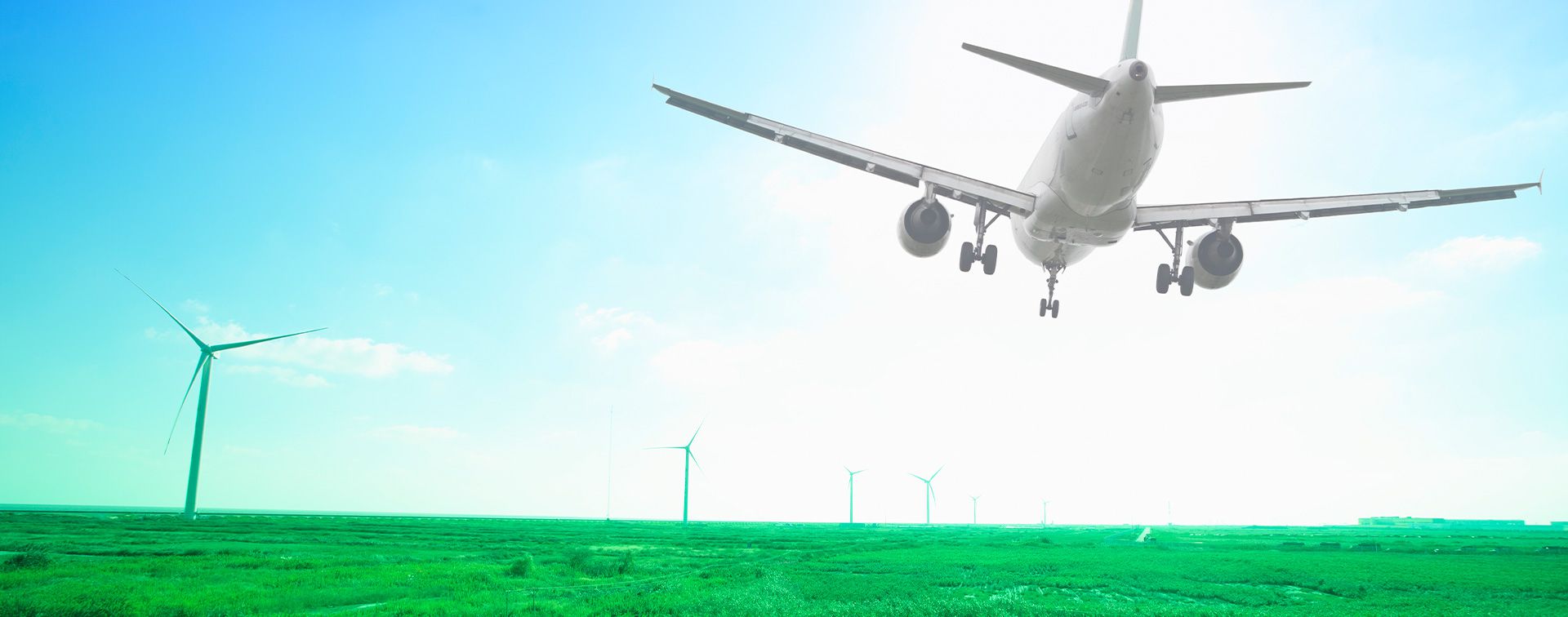
Charles Phillips is a researcher and consultant specialized in energy and climate change policy.
The global aviation industry is experiencing a crisis and facing pressures on multiple fronts. Not only has the Covid-19 pandemic reduced flying enormously, but the industry is now also facing mounting pressure to decarbonize to address the global climate crisis. The pandemic has, however, created an opportunity for the industry to build back with sustainability squarely in mind, systematically making flying cleaner and greener.
2021 has seen a substantial acceleration in worldwide ambition on climate action, with a growing number of countries, cities, and companies pledging to bring carbon emissions to net zero by 2050 to limit global temperature rise to 1.5°C in line with the Paris Agreement. Attention is now lasering in on all polluting sectors, with aviation front and center. The industry is responsible for 2% to 3% of global CO2 emissions, with around 1 billion tonnes of CO2 emitted in 2019 — more than those of Germany. The industry must cut emissions and do so quickly.

Given the energy requirements for powering planes and the absence of easily available alternatives to conventional jet fuel, the aviation sector is considered one of the most difficult to decarbonize. What’s more, despite the temporary downturn caused by the pandemic, new projections indicate that aviation demand is set to grow substantially in the coming decades — even under a highly ambitious net-zero-by-2050 scenario. Passenger numbers could increase from around 4.5 billion in 2019 to 10 billion in 2050, many of whom will come from emerging markets and developing economies. At present, most of the world’s population has never set foot on a plane and, in any given year, only a small percentage of the world’s population flies, with the average flyer taking multiple flights per year. Looking ahead, not only will the industry need to rapidly decarbonize its existing operations, but also its expanding operations.
A range of technologies are being considered to solve the sustainable aviation dilemma. These include electric planes, sustainable aviation fuels (SAFs), and hydrogen, but each comes with significant challenges. The technology that has received perhaps the most popular attention is electric aviation, whereby renewable electricity (solar and wind) is used to power batteries on planes. However, the batteries that are potent enough to power commercial flights, especially long-haul, are at present too heavy. Large improvements in battery energy density are needed for the technology to become widely adopted. Given the challenges in doing so, electric aviation looks likely to provide only a small part of the solution in the run up to 2050, useful only in smaller aircraft and in short-haul flights.
A technology shaping up to be the most promising is SAF, which encompasses two main fuel types: biofuels and synthetic fuels. Biofuels are made from organic matter such as plants, used cooking oil, or household and municipal waste. Synthetic fuels, also known as electrofuels or ‘e-fuels’, are artificially created to replicate conventional jet fuel — kerosene — and can be made using solar- or wind-powered electricity.
There have been several recent trial flights partly powered by SAFs. In February 2021, KLM operated the first passenger flight using synthetic fuel (5% of the plane’s fuel capacity) on an Amsterdam to Madrid flight. In May 2021, Air France operated the first long-haul flight using biofuel (16%) sourced from cooking oil. Biofuels have been in use longer than synthetic fuels — KLM operated the first commercial flight using 50% biofuel (50%) in 2011.
SAFs, however, are currently up to four times the cost of conventional jet fuel and face numerous obstacles. Biofuels require sufficient biomass to create the fuel, but there is not enough used cooking oil in the world today to power planes, and availability of land to grow crops for fuel is also scarce. Synthetic fuels consume a great deal of energy when they are produced, and the renewable electricity needed to produce the hydrogen component of the fuel is in high demand from other sectors seeking to electrify.
Another possibility for powering future flights is to use hydrogen directly, either by burning it in an engine or feeding it into a fuel cell, which would create electricity and power an electric motor. The hydrogen could be sourced from water using renewable electricity (‘green hydrogen’) or from natural gas, which would require the remaining carbon component of natural gas to be captured and buried underground (‘blue hydrogen’).
In September 2020, the world’s first commercial-grade flight powered by a hydrogen fuel cell took place using a small six-seater plane. In the same month, Airbus unveiled three concept designs for hydrogen aircrafts which it aims to put into service by 2035.
However, major challenges stand in the way. Hydrogen’s volume (in liquid form) is four times larger than kerosene’s, which means it takes up more space. Planes would have to be redesigned with larger fuel storage systems that would require new airport refueling infrastructure — all involving enormous levels of investment. Given the time required to scale up such technology, hydrogen looks more likely to come into use over the longer-term, playing a smaller role in the run up to 2050, and may be better suited to smaller aircraft and shorter flights.
Even if hydrogen- and electric-powered planes are eventually rolled out at scale, SAFs are poised to open a faster route for decarbonizing the aviation industry by 2050. The International Energy Agency’s ground-breaking new report, Net Zero by 2050, estimates that SAFs would need to make up 50% of aviation fuels by 2040, and 80% by 2050, in order to reach net-zero by 2050. The report’s net zero scenario envisages biofuel providing around 45% of global aviation fuel demand by 2050 and synthetic fuels meeting one third of demand. Kerosene would continue to provide some demand (20%) given the difficulties of completely decarbonizing the sector by 2050. Kerosene’s residual emissions would need to be offset by technologies that take CO2 directly out of the atmosphere. The report estimates battery electric and hydrogen aircrafts will have a limited role, with adoption of the technologies commencing from 2035 but accounting for less than 2% of fuel consumption by 2050. However, other organizations and scenarios project a larger role for battery electric and hydrogen aircrafts.
Transforming the aviation industry to such an ambitious degree will require serious action, including major technology advancements, large-scale investment, and concerted government policy and changes in consumer behavior. Higher taxes will need to be applied to carbon pollution from conventional fuels, and mandated aircraft fuel efficiency improvements will need to be made. Accompanying measures will also be required to constrain passenger aviation demand, including switching to high‐speed rail on routes where trains could offer similar journey times and limiting the expansion of both business and leisure long‐haul air travel.
Like all sectors, the aviation industry will increasingly feel the pressure to draw down emissions rapidly in the coming years. Only through unparalleled levels of cooperation between governments, the private sector, and the research community can sustainable aviation shift from being a lofty ambition to an everyday reality.
References
Airbus. “Airbus Reveals New Zero-Emission Concept Aircraft.” Airbus, September 21, 2020.
AP News Wire. “Air-France-KLM Launches First Long-Haul Flight with Eco-Fuel.” The Independent. Independent News & Media, May 18, 2021.
ATAG. Waypoint 2050. Air Transport Action Group, September 2020.
Coffey, H. “World’s First Hydrogen-Electric Passenger Flight Brings Us ‘One Step Closer’ to Zero-Emissions Air Travel.” The Independent. Independent News & Media, September 25, 2020.
Grant, J, and Baker, K. “How Will We Travel the World in 2050?” The Conversation. The Conversation Africa, Inc., August 14, 2019.
Henderson, C. “The Hydrogen Revolution in the Skies.” BBC News. BBC, April 8, 2021.
IEA. Net Zero by 2050 Report. International Energy Agency, 2021
Proper, E. “KLM Makes First Regular Flight with Sustainable Synthetic Fuel.” Bloomberg. Bloomberg L.P., February 8, 2021.